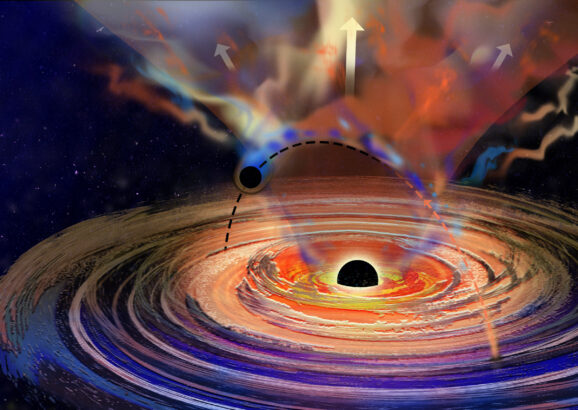Erin Kara
Class of 1958 Career Development Chair
Research Interests
Professor Kara is an observational astrophysicist, working to understand the physics behind how black holes grow and affect their environments. She has advanced a new technique called X-ray reverberation mapping, which allows astronomers to map the gas falling on to black holes and measure the effects of strongly curved spacetime close to the event horizon. She also works on variety of transient phenomena, such as Tidal Disruption Events, Quasi Periodic Eruptions and Galactic black hole outbursts. She also works to develop new and future space missions; she is the Deputy Principal Investigator of the AXIS Probe Mission Concept, which, if selected, will launch in 2032. She is also a NASA-selected Participating Scientist on several approved international space missions, including the newly launched XRISM Mission (focusing on high-resolution X-ray spectroscopy), the ULTRASAT mission (a UV all-sky time domain surveyor set to launch in 2027) and the LISA Observatory (a first low-frequency gravitational wave observatory to launch in 2035).
In search of answers to these questions, astrophysicist Erin Kara explores black holes by carefully tracking the gas and plasma swirling near their event horizons. To reconstruct the immediate environment, Kara turns to the X-ray light given off by the accretion disk, measuring the timing of photons using a telescope mounted on the International Space Station. This technique — called reverberation mapping — works in a manner similar to how bats ‘see’ using sound echolocation, allowing researchers to infer the structure of the gas and plasma with remarkable resolution. ———- Read the full article: https://www.quantamagazine.org/to-see… Video: Quanta Magazine/YouTube.
Biographical Sketch
Erin Kara is the Class of 1958 Career Development Assistant Professor of Physics. She is an observational astrophysicist, working to understand the physics behind how black holes grow and affect their environments. She also works to develop new and future space missions. She co-chairs the supermassive black hole working group of the XRISM Observatory, a joint JAXA / NASA X-ray spectroscopy mission to launch in 2023, and is the Deputy Principle Investigator of the AXIS Probe Mission Concept.
Erin is originally from Bethlehem, Pennsylvania, and attended Barnard College of Columbia University, where she obtained a B.A. in physics with a minor in art history. After graduating in 2011, she moved to the United Kingdom on a Gates Cambridge Scholarship to study for a Masters and a PhD from the Institute of Astronomy at the University of Cambridge. In 2015, she was awarded a NASA Hubble Postdoctoral Fellow, which she took to the University of Maryland and NASA’s Goddard Space Flight Center. In 2018, she became the Neil Gehrels Prize Postdoctoral Fellow at the University of Maryland, and joined the faculty of MIT as an Assistant Professor of Physics in July 2019. Recently, the American Astronomical Society awarded her the 2022 Newton Lacy Pierce Prize for ‘outstanding achievement, over the past five years, in observational astronomical research’.
More info:

Persistent “hiccups” in a far-off galaxy draw astronomers to new black hole behavior
Analysis reveals a tiny black hole repeatedly punching through a larger black hole’s disk of gas.
Awards & Honors
- 2023-24 // Harold E. Edgerton Faculty Achievement Award (MIT) recognizes exceptional distinction in teaching, research, and service at MIT
- 2023 // Alfred P. Sloan Research Fellow
- 2022 // Appointed Class of 1958 Career Development Professor
- 2022 // Newton Lacy Pierce Prize in Astronomy (AAS) "for her innovative and sustained contributions to high-energy astrophysics.”
- 2022 // Rossi Prize [shared], High-Energy Astrophysics Division of the AAS, as a Member of the NICER Science Team
- 2021 // MIT-Israel Zuckerman STEM Fund award by the MIT International Science and Technology Initiatives (MISTI) Program
- 2021 // MIT Solomon Buchsbaum Research Fund award "for launching new research initiatives that cut across disciplinary lines."
- 2019 // NASA Exceptional Scientific Achievement Medal "for outstanding and groundbreaking contributions to the scientific understanding of the geometry around stellar mass black holes."
- 2018-19 // Neil Gehrels Prize Fellowship , Joint Space-Science Institute
- 2018 // Kavli Frontiers of Science Fellow , National Academy of Sciences
Key Publications
-
Testing EMRI Models for Quasi-periodic Eruptions with 3.5 yr of Monitoring eRO-QPE1 Chakraborty, J., Arcodia, R., Kara, E., et al., 2024 The Astrophysical Journal 12
-
A New Population of Mid-infrared-selected Tidal Disruption Events: Implications for Tidal Disruption Event Rates and Host Galaxy Properties Masterson, M., De, K., Panagiotou, C., Kara, E., et al., 2024 The Astrophysical Journal 211
-
AGN STORM 2. I. First results: A Change in the Weather of Mrk 817 Kara, E., Mehdipour, M., Kriss, et al., 2021 The Astrophysical Journal 151
-
E. Kara, J. F Steiner, A. C. Fabian, et al., “The corona contracts in a black-hole transient”, Nature 565, 198 (2019)
